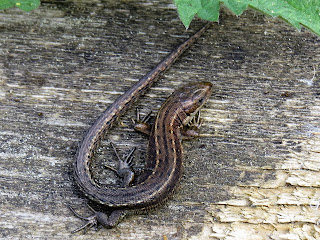 |
| Chiffchaff |
Mum and I were out of ideas to where to go today, so we decided that we would go to Strumpshaw for a walk. It turned out to be a nice day for it, though no where near as warm as yesterday. The birds were singing in full voice. Blackcaps, chiffchaffs, wrens, song thrushes, willow warblers, Cetti's warblers, a green woodpecker and even a couple of booming notes of a bittern made this late morning/ early afternoon chorus rather enjoyable. We also saw a treecreeper spiralling up a tree in the woods, a pair of common snipe and sky dancing marsh harriers at Fen Hide as well as a few swallows flying over the reserve.
 |
| Common Snipe |
 |
| Red Campion |
 |
| Coltsfoot |
 |
| Primrose |
 |
| Common Lizard |
Along the Sandy Wall, Mum was enjoying a bit of lizard spotting. I've never seen her get excited in finding something before. I guess it is because they don't move much while they bask on the wooden borders of the path, which makes them easier for anyone to spot. Still, once I found her the first lizard, she soon got the hang of spotting them and found a few more during our walk.
 |
| Dark-edged Bee-fly |
For me, it was the bugs that I was truly looking for. I showed Mum the tawny mining bees busy digging holes by the bench and I also saw plenty of spiders and hoverflies on the wooden borders. However, my bug highlight for today was this strange oddity. This is a dark-edged bee-fly. It looks bizarre doesn't it? That furry bee-like body and fierce-looking long spike protruding from it's head can make it appear like it could do you some harm if you annoyed it, but it is actually harmless. That spike is actually it's proboscis, which it uses to reach deep inside a flower like a primrose to extract the nectar it feeds on.
 |
| Tawny Mining Bee digging a hole! |
 |
| Hoverfly |
 |
| Wolf Spider (I think) |
 |
| Nursery Spider |
 |
| Some kind of bee |
 |
| Dark-edged Bee-fly |
Bee-flies are also a bit like tiny cuckoos. What I mean by that is that they lay their eggs into the nests of solitary bees, in which the bee-fly larvae will hatch out and feast on the bee larvae. The way the bee-fly places its eggs inside the bee's nesting chamber is actually more sneaky than simply crawling inside themselves. What they do is hover at the entrance hole of the bee's nesting chamber and shoot them in! They are very accurate at it too. The bee returns none the wiser of what has happened. Try doing that with your Easter eggs!

















No comments:
Post a Comment